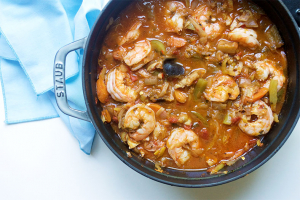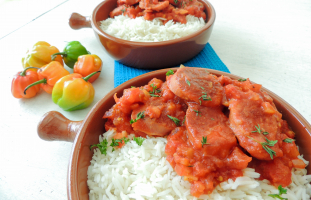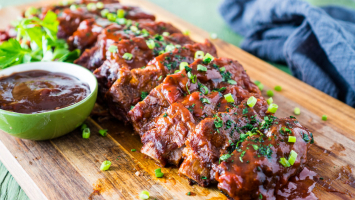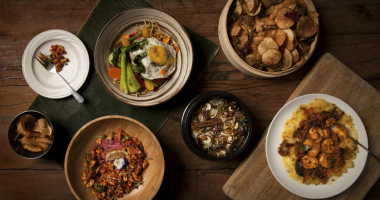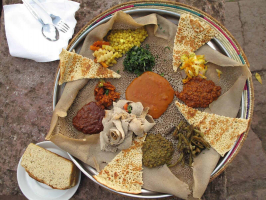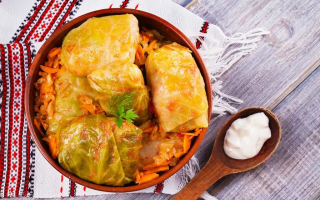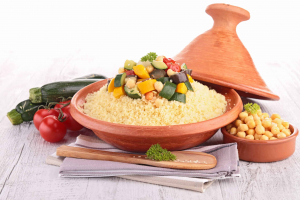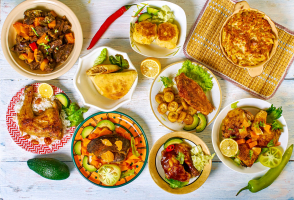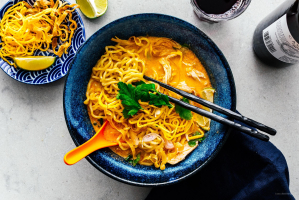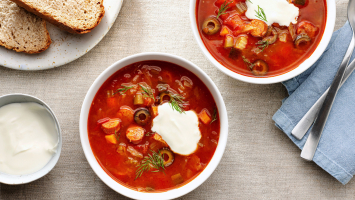Top 10 Best Foods In Korea With Recipe
In bustling Seoul, great Korean food can be found almost anywhere, from street sellers along small alleyways to sophisticated restaurants within 5-star hotels. ... read more...Many of these delicacies have been around for almost 2,000 years and were formerly solely available to Korea's royal family. Korean cuisine has grown in popularity to the point where locals and visitors alike describe it as savory, spicy, hearty, and nutritious delights that can be enjoyed at any time of day. Toplist has put up a list of the best Korean delicacies in Seoul that you must try during your visit to South Korea's capital.
-
This traditional Korean cuisine dates back to the Shilla Dynasty and has been around for almost 2,000 years. Kimchi is made by fermenting Korean cabbage, radish, pumpkin, onion, ginger, and scallion with chili powder, crushed garlic, and salty fish. This traditional food, which comes in over 200 varieties in Seoul, is eaten on its own or with white rice, and is also used in porridges, soups, and rice cakes. Kimchi is also used to make kimchi stew (kimchi jjigae), kimchi pancake (kimchijeon), and kimchi fried rice, among other meals.
Ingredients
- 1 medium head napa cabbage (about 2 pounds)
- 1/4 cup iodine-free sea salt or kosher salt (see Recipe Notes)
- Water, preferably distilled or filtered
- 1 tablespoon grated garlic (5 to 6 cloves)
- 1 teaspoon grated peeled fresh ginger
- 1 teaspoon granulated sugar
- 2 tablepoons fish sauce or salted shrimp paste, or 3 tablespoons water
- 1 to 5 tablespoons Korean red pepper flakes (gochugaru)
- 8 ounces Korean radish or daikon radish, peeled and cut into matchsticks
- 4 medium scallions, trimmed and cut into 1-inch pieces
Instructions
- Cut the cabbage into small pieces. Quarter the cabbage by cutting it lengthwise through the stalk. Remove the cores from each of the pieces. Cut each quarter into 2-inch-wide strips crosswise.
- Season the cabbage with salt. Sprinkle the salt over the cabbage in a large mixing dish. Massage the salt into the cabbage with your hands until it softens a little. Cover the cabbage with enough water to keep it submerged. Place a plate on top of the cabbage and weigh it down with a heavy object, such as a jar or a can of beans. Allow for 1 to 2 hours of resting time.
- Clean the cabbage by rinsing it and draining it. Rinse the cabbage three times in cool water. Allow 15 to 20 minutes to drain in a colander. Make the spice paste in the meantime.
- Make a paste with the spices. The bowl you used for salting should be rinsed and dried. To make a smooth paste, combine the garlic, ginger, sugar, fish sauce, shrimp paste, or water. Set aside until the cabbage is cooked, stirring in the gochugaru, using 1 tablespoon for mild and up to 5 teaspoons for spicy (I like approximately 3 1/2 tbsp).
- Combine the veggies and spice paste in a mixing bowl. Squeeze out any excess liquid from the cabbage and toss it in with the spice paste. Combine the radish and scallions in a mixing bowl.
- Make a thorough mix. Gently mix the paste into the veggies with your hands until they are well covered. Gloves are not required, however they are strongly suggested to protect your hands from stings, stains, and odors!
- Fill the container halfway with kimchi. Fill a 1-quart container halfway with kimchi. Press the kimchi down until the brine (the liquid that comes out) rises to cover the veggies, leaving at least 1 inch of room at the top. Close the jar.
- Allow 1 to 5 days for fermentation. Put a basin or plate underneath the jar to catch any spills. Allow 1 to 5 days for the jar to sit at room temperature, out of direct sunlight. Inside the jar, bubbles may appear, and brine may seep out of the lid.
- Check it every day and refrigerate it when it's done. Once a day, open the jar and gently press down on the veggies with a clean finger or spoon to keep them buried in the brine. (Gase generated during fermentation is also released.) At this stage, try a little bit of everything! Transfer the container to the refrigerator when the kimchi is mature enough to your liking. You can eat it right immediately, but it'll taste best in a week or two.
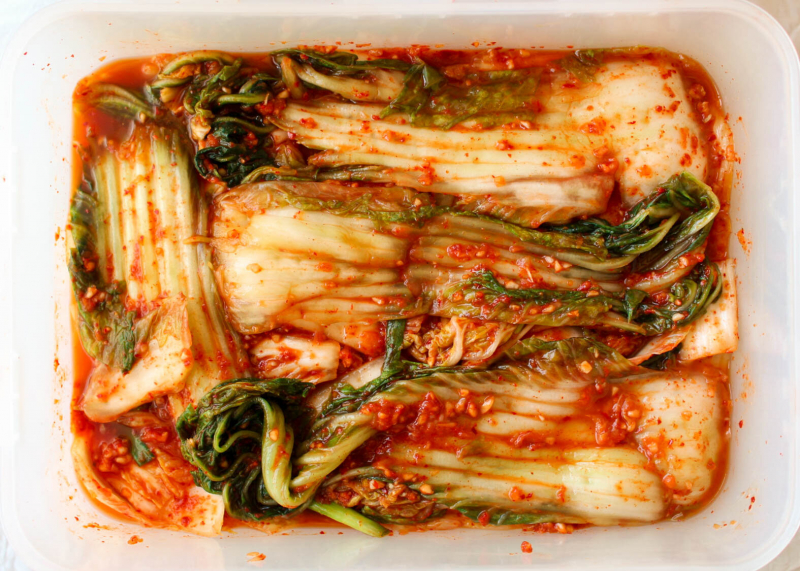
Photo: maangchi.com 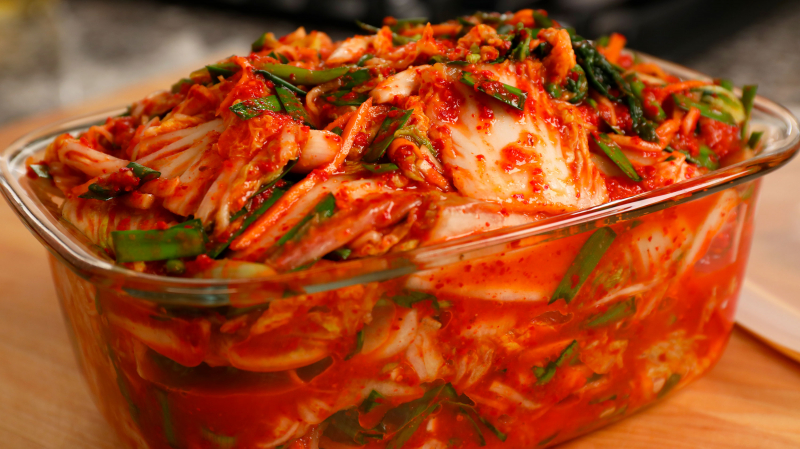
Photo: ahnestkitchen.com -
Bibimbap, a substantial and healthy meal frequently accessible in restaurants, food courts, and street markets, is another must-try during your vacation to Seoul. Bibimbap can be served as a meat-based or vegetarian cuisine, depending on the area and ingredients utilized. Warm rice is topped with mixed veggies, beef or chicken, raw egg, soy sauce, and a dab of chilli pepper paste for spice in the most typical bibimbap. A version of this Korean mixed rice meal called hoedeopbap, which replaces meat with raw seafood like salmon, tuna, or octopus, is ideal for seafood enthusiasts.
Ingredients
- 100g / 3.5 ounces beef mince (or other cuts)
- 1 Tbsp soy sauce
- 1 Tbsp sesame oil
- 1 tsp brown sugar
- 1/4 tsp minced garlic
- 250g (0.6 pounds) seasoned spinach
- 350g (0.8 pounds) seasoned bean sprouts – (You don’t have to use them up if you think it’s too much but I love haing lots of vegetables on my bibimbap!)
- 100g (3.5 ounces) shiitake mushroom
- 120g (4.2 ounces) carrots (1 small)
- 1/2 tsp fine sea salt (1/4 tsp each will be used when cooking shiitake mushroom and carrots)
- 3 to 4 serving portions of steamed rice3 or 4 eggs (depending on the serving portion)
- Some cooking oil to cook the meat, mushroom, carrots and eggs – I used rice bran oil.
- Some toasted seasoned seaweed, shredded (long thin cut)
Instructions
- Preheat a skillet over medium-high heat. Squeeze the carrot to remove any extra water. 1 minute after adding a few drops of cooking oil to the pan, sauté the carrots. Place it next to the soy bean sprouts and spinach on the dish. Use a moist paper towel to wipe off the pan or wash it.
- In a small saucepan, heat a few drops of cooking oil and squeeze off the excess water from the cucumber. Sauté for 30 seconds with 12 teaspoon minced garlic and a few drops of toasted sesame oil. Place it on the serving plate. Clean the frying pan.
- Using a few droplets of cooking oil, heat the pan. Sprinkle a teaspoon of salt on top of the red bell pepper. 30 seconds of sautéing Place it on the serving plate. Clean the frying pan.
- Preheat the pan. Using a dropper, add a few drops of cooking oil. Stir the gosari for 2 minutes, or until it has softened a little. Continue to sauté for another minute after adding 12 teaspoon minced garlic, 2 teaspoons soy sauce, and 2 teaspoons sugar. Place it on the serving plate.
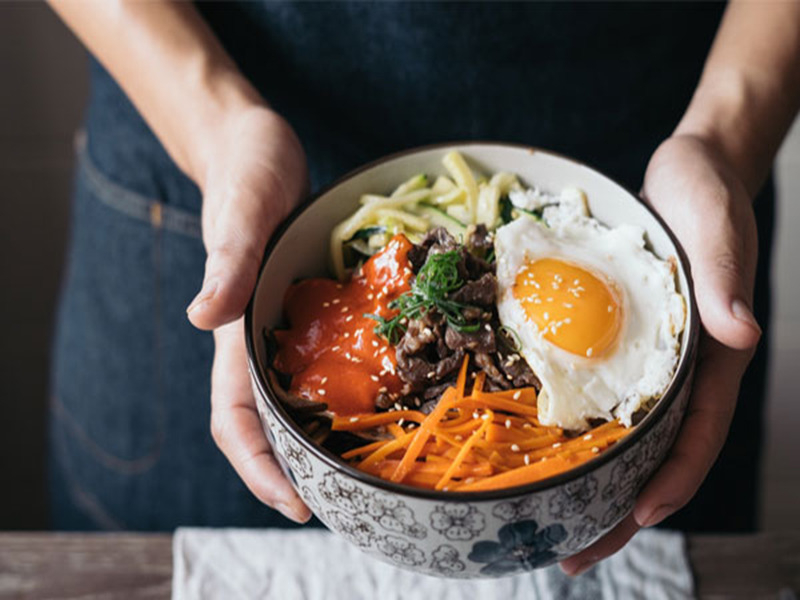
Photo: muahohanquoc.com/bibimbap/ 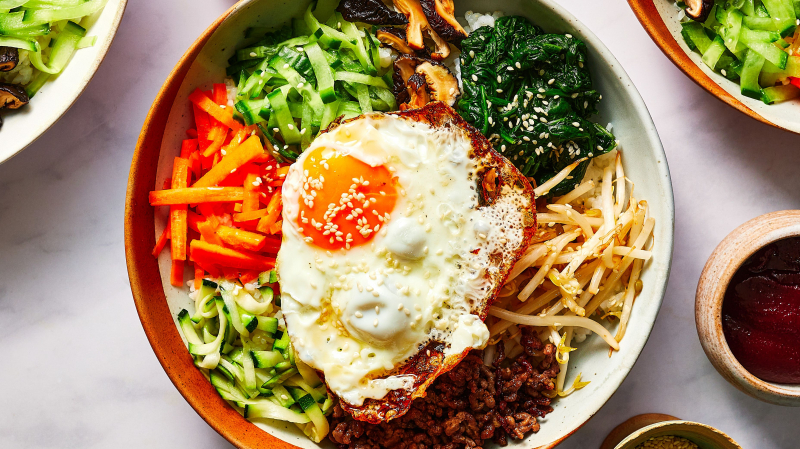
Photo: thespruceeats.com -
Tteokbokki is a typical Korean street snack consisting of thick slices of garaetteok (boiled rice cake), fish cake, onions, sliced garlic, salt, sugar, and other veggies stir-fried in sweet red chili sauce. This famous delicacy is generally offered by street vendors and independent snack bars, and is distinguished by its vibrant red-orange ensemble.
Ingredients
- 350g / 12 ounces Korean rice cakes, separated
- 150g / 5.3 ounces Korean fish cakes, rinsed over hot water & cut into bite size pieces
- 2 cups Korean soup stock (dried kelp and dried anchovy stock), use this recipe
- 60g / 2 ounces onion, thinly sliced
- 3 Tbsp gochujang (Korean chili paste)
- 1 1/2 Tbsp raw sugar
- 1 Tbsp soy sauce
- 1 tsp minced garlic
- 1 tsp gochugaru (Korean chili flakes)
- 1 tsp roasted sesame seeds
- 1 tsp sesame oil
- 1 stalk green onion, finely chopped
Instructions
- Soak your rice cakes in warm water for 10 minutes unless they're already soft.
- In a small saucepan over medium high heat, bring the soup stock to a boil, then mix in the tteokbokki sauce with a spatula to dissolve it. Add the rice cakes, fish cakes, and onion to the boiling seasoned stock. Cook for 3 to 5 minutes more, or until the rice cakes are thoroughly cooked. Then, to thicken the sauce and intensify the taste, cook it for another 2 to 4 minutes over low heat.
- Quickly whisk in the sesame oil, sesame seeds, and green onion. Warm the dish before serving.
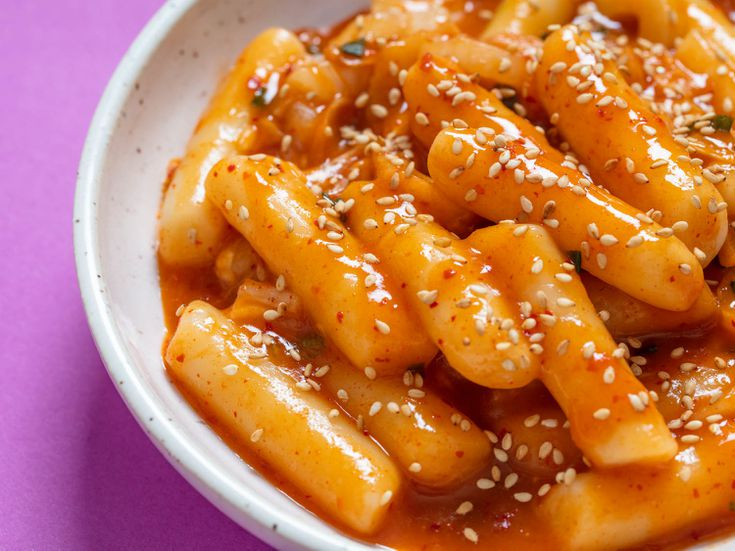
Photo: seriouseats.com 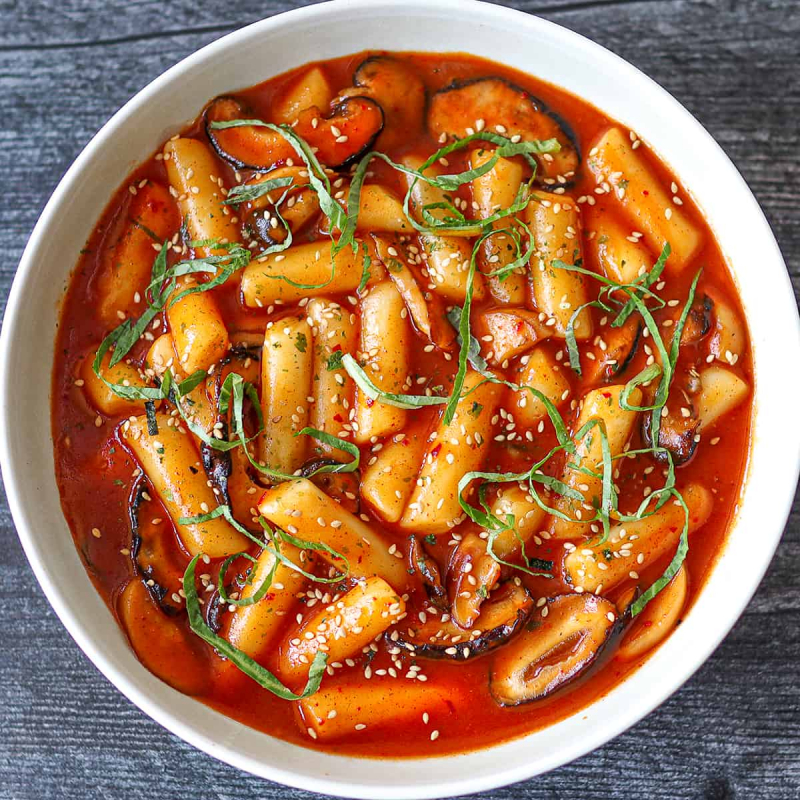
Photo: chefatulya.com/ -
Bulgogi is made with thin slices of marinated beef sirloin grilled with sliced onions, green peppers, and garlic over a charcoal fire, giving it a characteristic smokey flavor. To increase the flavor and softness of the meat, it is marinated for 2 to 4 hours in a combination of soy sauce, sesame oil, black pepper, garlic, onions, ginger, and sugar before grilling. This meal also comes with a side of lush greens like lettuce and spinach, which are used to wrap a piece of cooked beef, which is commonly accompanied by ssamjang (spicy paste) and kimchi.
Ingredients
- ½ onion
- 3 green onions/scallions
- 4 inch carrot
- 1 ½ lb thinly sliced beef
- 1 Tbsp roasted sesame oil
- ½ Tbsp toasted white sesame seeds
- 4 Tbsp Korean soy sauce
- 2 Tbsp roasted sesame oil
- 3 Tbsp brown sugar
- 8 cloves garlic (4 tsp, minced)
- ½ Asian pear
- freshly ground black pepper
Instructions
- Gather all the ingredients.
- To make the bulgogi marinade, add 4 Tbsp soy sauce, 2 Tbsp sesame oil, and 3 Tbsp brown sugar, and crush 8 cloves garlic (or minced garlic) in a large bowl.
- Grate ½ of an Asian pear.
- Add freshly ground black pepper and mix all together.
- Cut the onion into thin slices and cut the green onion into 2 inches (5 cm) pieces and then cut in half lengthwise.
- Using a peeler, peel some carrot (or slice thinly). Add the onion, green onions, carrot in the marinade, and mix all together.
- Add the meat in the marinade, separating each slice. Mix all together to coat with the marinade. I wear plastic gloves so I can mix them thoroughly.
- Set aside for at least 30 minutes or best if overnight.
- In a large skillet (I use a cast iron grill pan here), heat 1 Tbsp sesame oil over medium-high.
- Cook the marinated meat in a single layer until cooked through, about 5 minutes. Transfer the meat to the plate and sprinkle with sesame seeds.
- If you have a single serving cast iron plate, you can use it to keep the meat warm for a longer time.
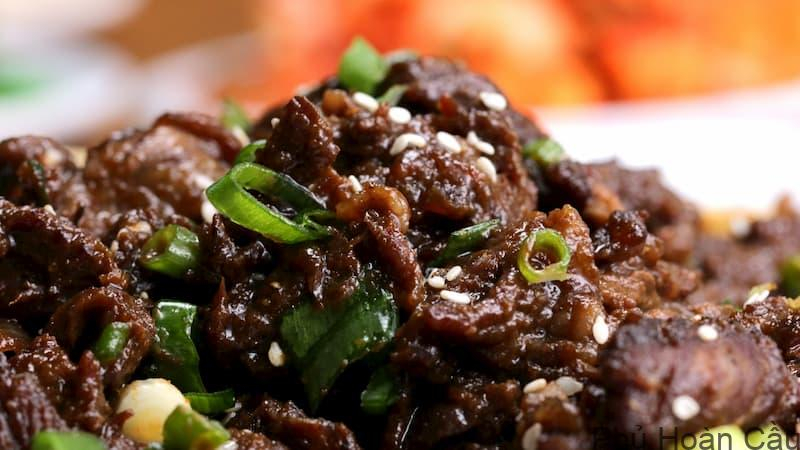
Photo: phuhoancau.edu.vn 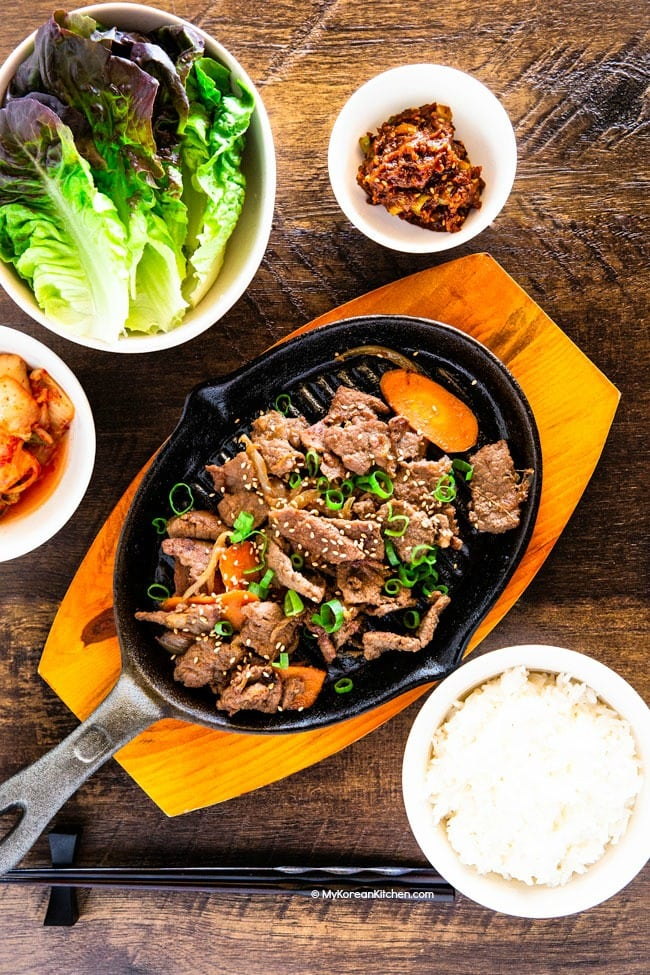
Photo: 2dep.vn -
Jajangmyeon is a Korean-Chinese fusion meal composed with thick handmade wheat noodles, fresh cucumber slices, and a salty black soybean paste, chopped pork, and veggies. This substantial noodle dish, which starts at 5,000 won, is ideal for times you need a fast dinner that won't break the bank. It is also commonly consumed by singles on Black Day, which occurs every year on April 14th. Those who do not get presents on Valentine's Day dress in black and congregate to eat black foods like as jajangmyeon.
Ingredients
- MAIN
- 1kg (35 ounces), fresh jajangmyeon noodles (Or you can use fresh udon or ramen noodles)
- 1 large onion (150g / 5.3 ounces)
- 1 medium zucchini (110g / 3.9 ounces)
- 2 large potatoes (470g / 1 pound)
- 7 large button mushrooms (240g / 0.5 pounds)
- 1/4 small cabbage (160g / 5.6 ounces)
- 600g / 1.3 pounds diced pork
- PORK MARINADE SAUCE
- 1 Tbsp rice wine (mirin)
- 5 sprinkles ground salt
- 5 sprinkles ground black pepper
- 1/4 tsp ginger powder
- KOREAN BLACK BEAN SAUCE
- 6 Tbsp Korean black bean paste (Chunjang, 춘장)
- 90g / 3.2 ounces lard (or 6 Tbsp cooking oil – e.g. rice bran oil)
- 2 Tbsp brown sugar
- 4 Tbsp rice wine (or mirin)
- 1 cup chicken stock (as natural as possible)
- 1 cup water
- Slurry (potato starch 5 Tbsp + water 4 Tbsp)
- TOPPINGS
- 1 large cucumber (150g / 5.3 ounces)
- Peas or sweet corn (from a tin, alternative)
- Hard boiled egg (alternative)
Instructions
- Rinse the pork in cold water and pat it dry with kitchen paper. Add the pork marinade sauce onto the pork. Mix them well and leave it for 15 mins.
- Cut the onion, zucchini, and potato into small cubes.
- Thin slice the mushrooms.
- Cut the cabbage into small to medium size pieces.
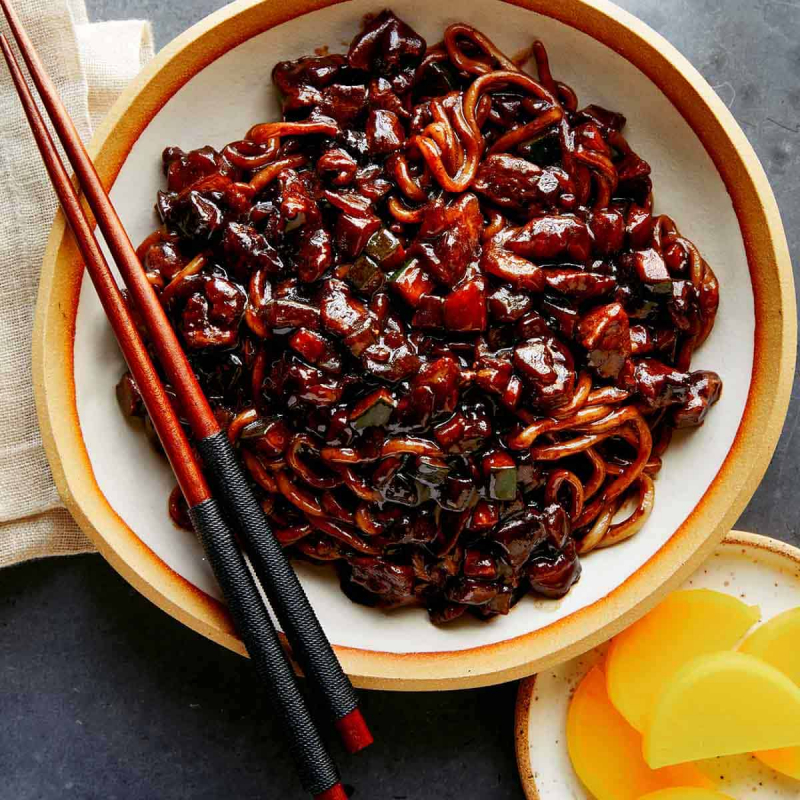
Photo: spoonforkbacon.com 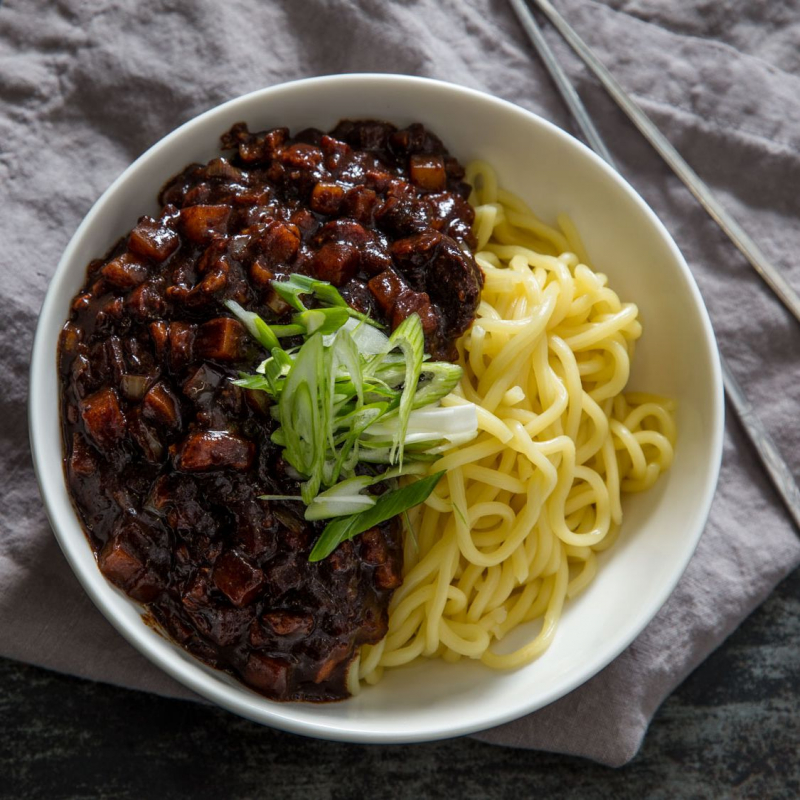
Photo: seriouseats.com -
Samgyeopsal is a South Korean delicacy made entirely of pork belly, the country's most costly cut of meat. It is so popular in South Korea that inhabitants eat it every four days on average. The dish's name is made up of three words: sam (three), gyeop (layered), and sal (meat), therefore it literally translates to "three-layered meat." The meal is thought to have gained popularity in the 1960s, when the price of soju dropped and people wanted a dish to go with it, so they picked pork belly because it was cheap at the time. Samgyeopsal is usually prepared at the table, whether at home or in restaurants, in a special pan that allows the fat to flow over the edges. Lettuce, raw garlic, green chili peppers, kimchi, and green onions are the most typical accompaniments. On the side, there are two dipping sauces: ssamjang (sesame oil, chili paste, and soybean paste) and gireumjang (sesame oil, salt, and black pepper).
Ingredients
- 1 pound sliced fresh pork belly (samgyupsal, 삼겹살)
- 8 cloves garlic, thinly sliced
- 4 green chili peppers, roughly sliced
- 3 - 4 scallions, thinly sliced (or pa muchim)
- 2 to 4 ounces mushroom caps - white, crimini, or king mushrooms - optional
- 4 chili peppers - optional
- 2 heads of red or green lettuce
- 16 perilla leaves, kkaennip (깻잎) - optional
Instructions
- Prepare the vegetables. Mix the sauce ingredients for each sauce.
Heat the grill (or a flat pan or grill pan). Cut the pork belly strips in shorter bite size pieces. You can also grill first andcut into bite sized pieces with kitchen scissors. - Add the meat to the grill along with the garlic, chili peppers, and any other vegetables you are using. Grill over moderate heat until cooked through, flipping once. It's best to serve right off the grill or pan as you cook.
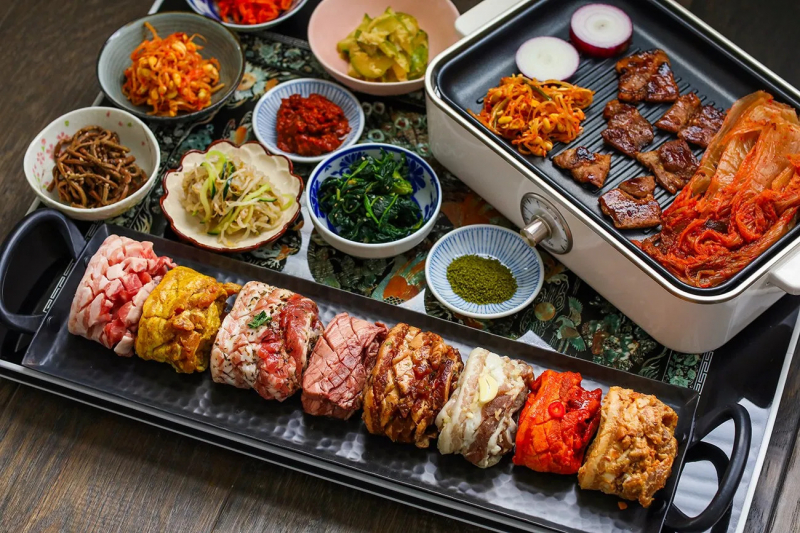
Photo: maggi.ph 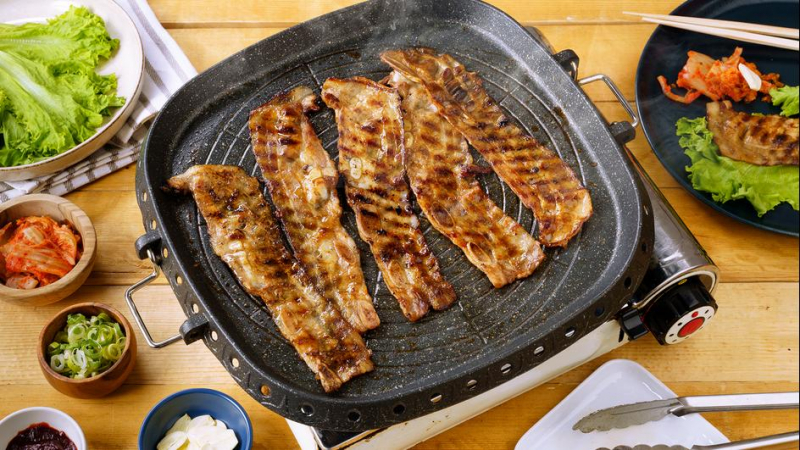
Photo: seonkyounglongest.com -
Korean fried chicken reinvents the classic American fast food with its own distinct flavor. Unlike its American equivalents, the chicken is covered in a sweet and spicy sauce before being double-fried in vegetable oil. Some restaurants add green pepper to the batter for a stronger kick. As a result, the interior of the meat is extremely moist, while the lightly battered skin is crispy and free of greasy. It's a popular late-night snack that's usually accompanied by a glass of beer.
Ingredients
- FOR WINGS
- Vegetable oil
- 1 tsp. kosher salt
- 1/2 tsp. freshly ground black pepper
- 1/2 tsp. baking powder
- 1/2 tsp. garlic powder
- 2 lb. chicken wings
- 1 tbsp. freshly grated ginger
- 1/2 c. cornstarch
- FOR SAUCE
- 3 tbsp. butter
- 5 small dried red chilis, sliced3 cloves garlic, minced
- 1/4 c. gochujang
- 2 tbsp. ketchup
- 1 tbsp. rice vinegar
- 1 tbsp. low-sodium soy sauce
- 1/4 c. honey
- 2 tbsp. packed brown sugar
- FOR GARNISH
- 1/2 c. cocktail peanuts
- 1 tbsp. sesame seeds
- 1 green onion, sliced
Instructions
- To make the wings, follow these steps: Heat 4 to 6 cups vegetable oil to 275° in a deep saucepan over medium-high heat. Paper towels should be used to line a big dish or baking sheet. Combine salt, pepper, baking powder, and garlic powder in a small basin.
- Dry the wings using paper towels before rubbing them with grated ginger and seasoning them with the salt mixture. Toss wings with cornstarch in a large mixing basin and crush to compact coating onto each wing.
- Carefully place wings in the oil and fried until the skin is lightly crisped and brown, approximately 15 to 18 minutes, turning with tongs as needed. Remove the wings from the oil and place them on a platter that has been prepared. Allow it cool for a few minutes.
- Preheat the frying oil to 400 degrees. Return the wings to the saucepan and cook for another 7 to 8 minutes, or until the skin is crisp and crispy. Place the wings in a large mixing bowl after removing them from the oil.
- To make the sauce, follow these steps: Butter, dried chilis, ginger, and garlic in a medium saucepan over medium-low heat until aromatic, about 2 minutes. Cook until gochujang, ketchup, vinegar, and soy sauce have bubbled up. Cook, stirring constantly, until the honey and brown sugar have dissolved and the sauce has thickened somewhat.
- Toss the wings in the sauce until they are uniformly covered. Toss in the peanuts to mix.
- Before serving, sprinkle with sesame seeds and green onion.

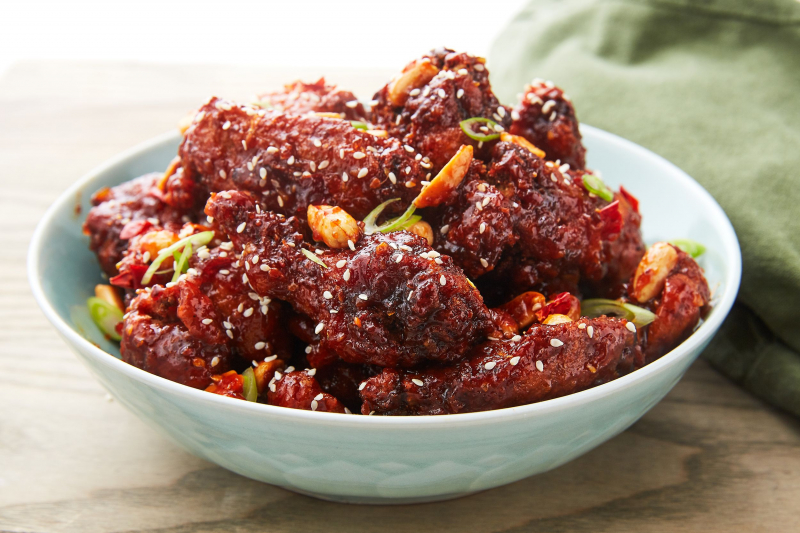
-
In a stainless steel bowl, bibim nengmyun is served with a cold broth, julienned cucumbers, Korean pear slices, boiled egg, and cold boiled beef slices. Flour and buckwheat or sweet potatoes are used to make the long and thin noodles, however seaweed and green tea are also used in certain varieties. The noodles are generally given without cutting, symbolizing longevity and good health, although diners can request that the noodles be sliced according to their preferences.
Ingredients
- 3 to 4 handfuls green cabbage (add some purple cabbage too if you like!)
- 3 to 4 oz carrot, thinly julienne
- 3 to 4 oz cucumber, thinly julienne
- 1 tsp sesame oil
- 1 tsp sesame seeds
Instructions
- In a mixing dish, combine all sauce ingredients and leave aside. To add more nutty taste, sprinkle sesame seeds on your palm and smash them between your palms. This sauce will keep for 2 weeks in the fridge.
- Cook the noodles according to the package guidelines. After they've finished cooking, rinse them under cold or ice water, massaging them with your hands to chill them down and remove any leftover starch. The noodles will have a more elastic and chewy feel this way!
- Drain well and combine with all veggies and sauce in a large mixing bowl. Using your hands, thoroughly combine the ingredients. If you don't use plastic gloves, the spicy fragrance and burn will stick on your finger tips! That's excruciating!!
- Drizzle some sesame oil and sesame seeds over the top and serve! Finish with half hard boiled eggs and you're good to go! Enjoy!
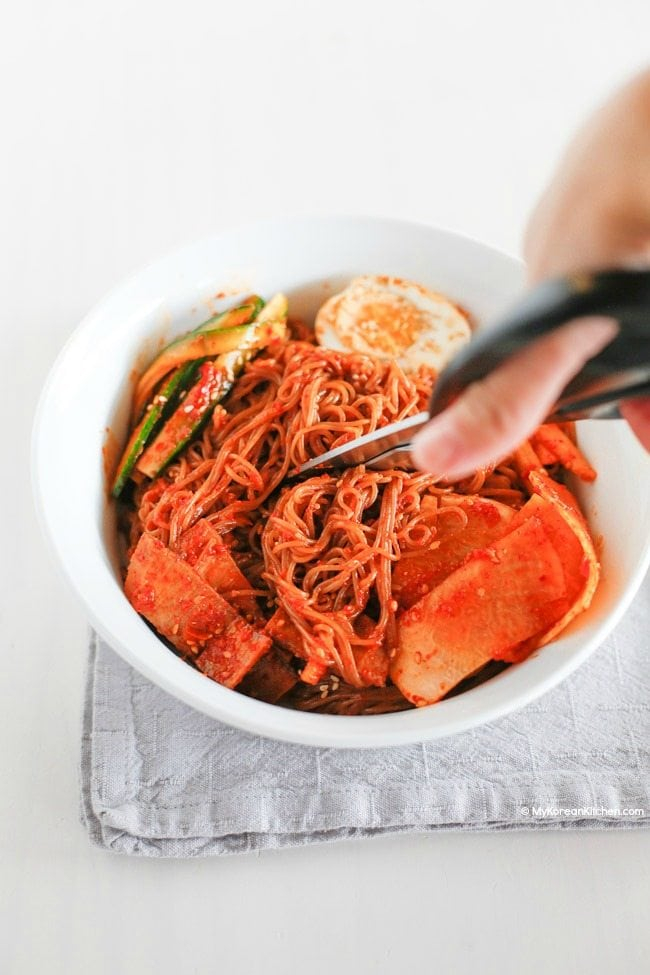
Photo: mykoreankitchen.com 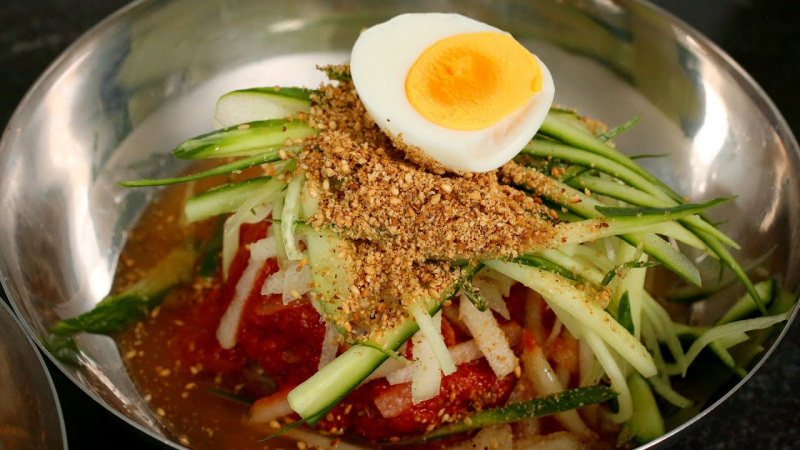
Photo: youtube.com -
Locals think that the body's vitality needs to be renewed throughout the summer, therefore eating a steaming bowl of samgyetang (chicken ginseng soup) is a typical activity between June and early September. A little spring chicken is filled with chestnuts, garlic, dried jujubes, ginseng, sticky rice, and gingko nuts in this healthy soup. Slowly boil the ingredients until the beef is quite soft and the thick soup has a somewhat bitter yet aromatic flavor.
Ingredients
- 2 cornish hens. Each hen weighs about 1½ pounds, a nice portion for 1 person.
- ½ cup short grain rice (or glutinous rice), rinsed and soaked in cold water for 1 hour.
- 2 fresh ginseng roots, washed
- 2 large dried jujubes, washed
- 16 garlic cloves, washed and the tips are removed
- 2 to 3 green onions, chopped
- kosher salt
- ground black pepper
Instructions
- In a small mixing bowl, combine salt, sesame seeds, ground black pepper, and toasted sesame oil. Remove from the equation.
- In a separate dish, combine the soy sauce, vinegar, and honey (or sugar). Using a spoon, thoroughly combine the ingredients. Toss in the onion and jalapeño. Remove from the equation.
- Remove the rice from the pot and strain it.
- Remove the hens' giblets and massage them all over with salt to clean them up properly. Rinse well with cold running water.
- Place the chickens on a cutting board, pat dry, and use kitchen scissors to trim away any excess fat around the body cavities. If you like, you may trim the tips of the wings.
- Rice, 1 ginseng, 1 jujube, and 8 garlic cloves should be stuffed into each fowl. Fill the pot with any remaining rice.
- Turn down the heat to medium and cook another 40 minutes until the chicken, ginseng, and rice turn soft. Open up the pot from time to time and ladle some broth from the bottom over top of the chickens. If the broth evaporates too much, add more water.
- Remove from the heat.
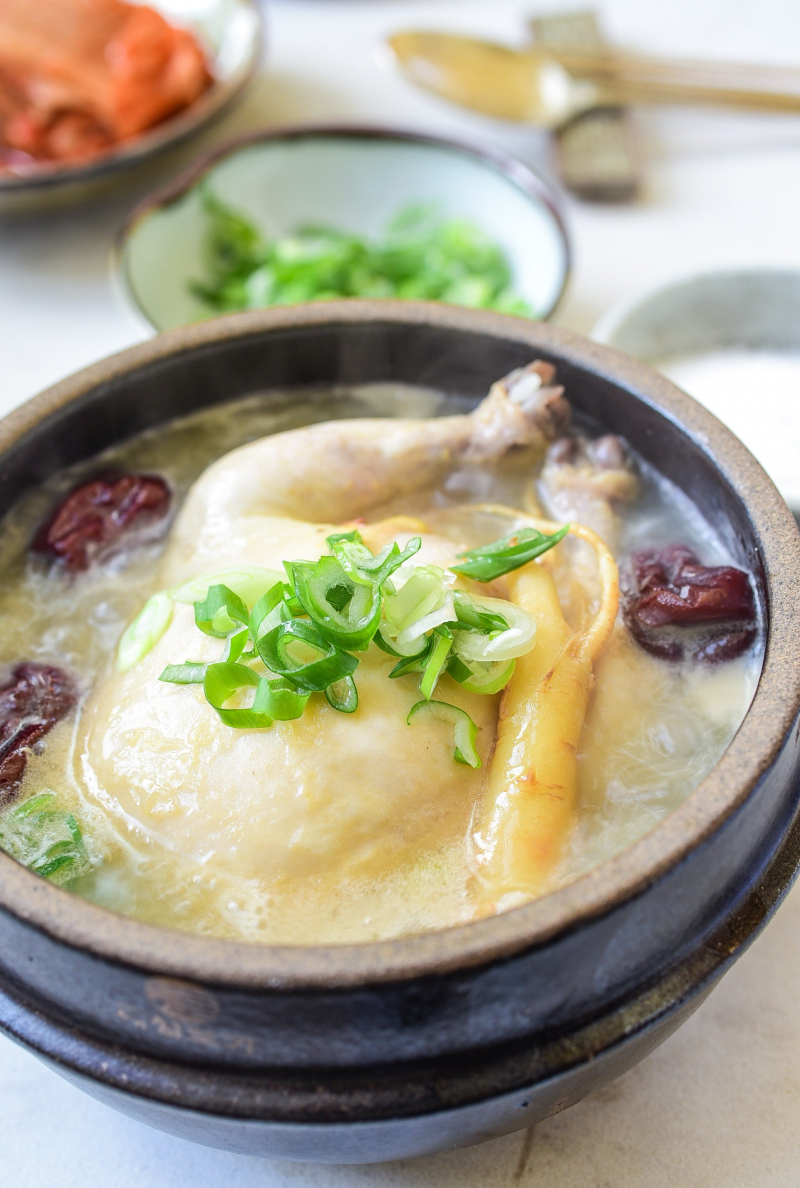
Photo: maangchi.com 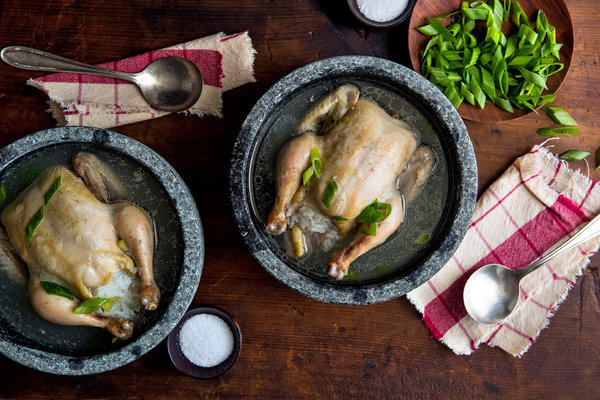
Photo: cooking.nytimes.com -
Locals think that the body's vitality needs to be renewed throughout the summer, therefore eating a steaming bowl of samgyetang (chicken ginseng soup) is a typical activity between June and early September. A little spring chicken is filled with chestnuts, garlic, dried jujubes, ginseng, sticky rice, and gingko nuts in this healthy soup. Slowly boil the ingredients until the beef is quite soft and the thick soup has a somewhat bitter yet aromatic flavor.
Ingredients
- 1 1/2 pound slab pork belly (680g), preferably skin-on
- Rice-rinsing water (optional; see note)
- 3 tablespoons (45ml) doenjang (Korean fermented soybean paste)
- 1 whole medium yellow onion, skin on
- 10 scallions or 3 daepah (Korean giant scallions)
- 1/2 medium apple
- 1 thumb-size knob fresh ginger, peeled
- 1 (1-inch; 2cm) piece cinnamon stick
- 10 whole medium garlic cloves
- 1 teaspoon whole black peppercorns (about 15)
- 1 small bay leaf
- 1/4 cup (60ml) soju or vodka
Instructions
- Combine sugar, vinegar, kosher salt, and water in a large bowl. Mix well until it turns into a clear pickle brine.
- Add the cabbage and mix well by hand.
- Let it sit for 15 minutes, then mix well and turn it over so the leaves pickle evenly. Repeat this every 10 to 15 minutes for 1 to 2 hours until the cabbage gets soft and withered.
- Squeeze out the excess water and refrigerate until ready to serve.
- In a large saucepan, combine the pork, onion, ginger, garlic, soy bean paste, brown sugar, hazelnut coffee powder, and water. Cook for 1 hour over medium high heat, covered.
- Turn the pork over with a wooden spoon or tongs when it begins to boil fiercely.
- Reduce the heat to low and cook for another 15 minutes after 1 hour of boiling.
- Remove the cooked pork from the pan and set aside to cool until ready to serve.
- Squeeze out the excess water and put it back into a bowl.
- Take the oysters out of the fridge and wash and drain.
- Create a seasoning mixture by combining hot pepper flakes, fish sauce, sugar, garlic, and green onion in a bowl. Mix well with a wooden spoon.
- Add the seasoning mixture to the radish and mix well by hand. Add the oysters and mix it gently. Add the sesame seeds.
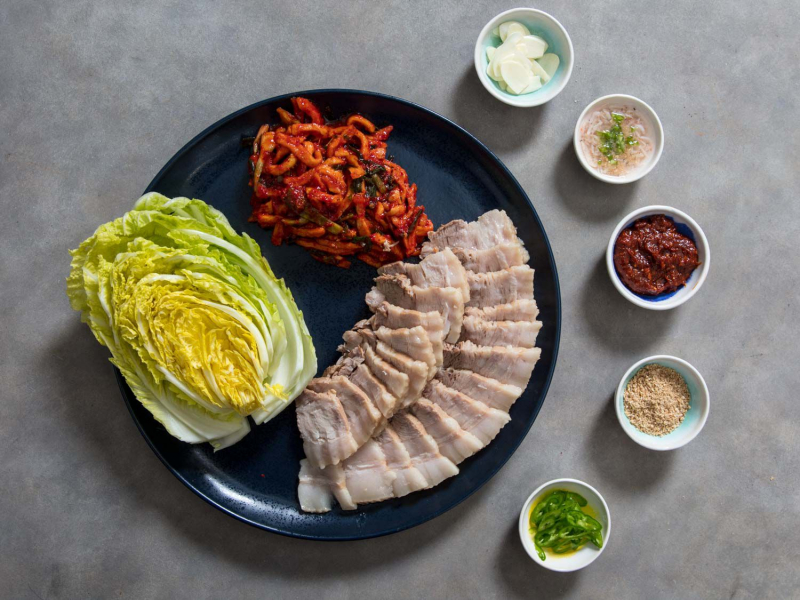
Photo: seriouseats.com 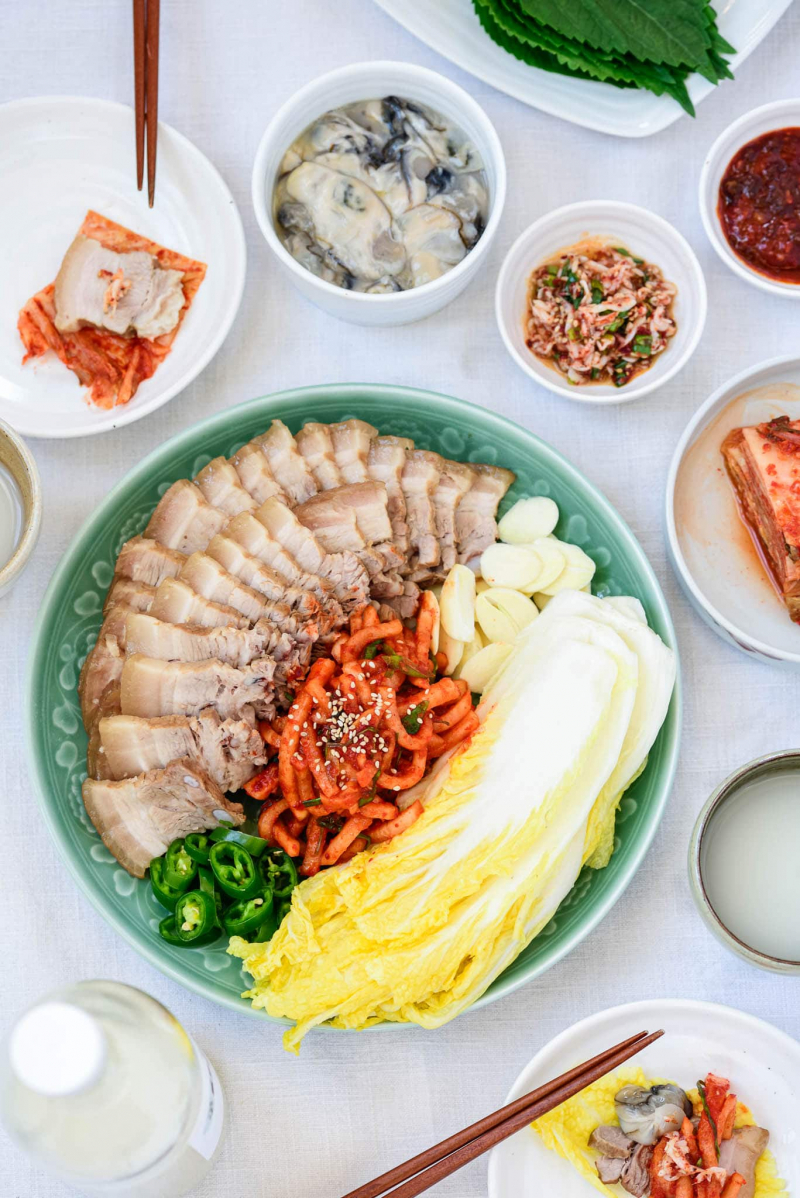
Photo: koreanbapsang.com













